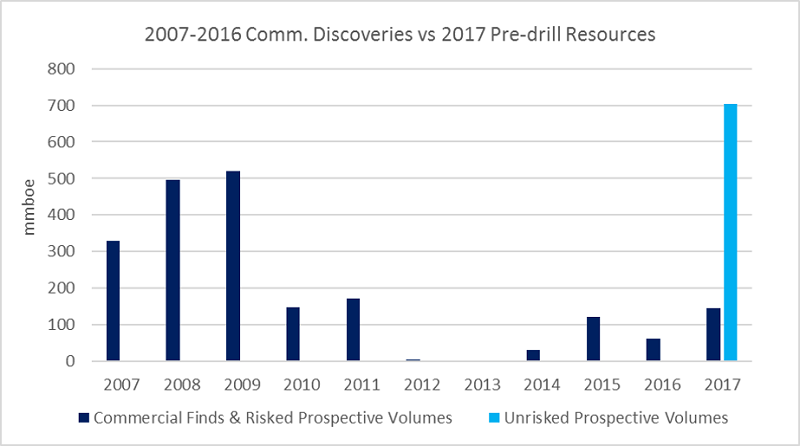Six of the offshore exploration wells that are set to drill in the UK in 2017 have an average pre-drill prospect volume of over 100 million barrels of oil equivalent (mmboe). Does this signal a renaissance for UK exploration or are explorers being overly optimistic when the average commercial discovery size has been only 18 mmboe since 2012 in this ‘super-mature’ basin?

Resources discovered in the ten years 2007 – 2016 vs pre-drill prospective volumes for planned 2017 exploration wells in the UK
Source: Westwood analysis
Exploration commercial success rates offshore the UK have improved in the past two years to over 40% and represent the highest for over a decade, but with the majority of targets comprising near-field prospects, discoveries have generally been small. However, six conventional exploration wells planned in the UK this year have the combined potential to discover close to 700 mmboe according to operators. Is this realistic?
One reason to be cautious is that there is a tendency for explorers to over-estimate pre-drill actual discovery sizes – typically by a factor of 1.5 – 2 in both the UK and Norway, according to Westwood analysis. A second reason is that in the UK, the 200+ conventional exploration wells drilled in the past decade have resulted in only two commercial discoveries that are 100 mmboe or greater (i.e. 1 in a 100).
So why the apparent optimism in 2017? One explanation could be the demographic of the exploration drillers set to spin the bit this year. Five of the six wells are operated by major oil companies – BP, Statoil (two), Total and CNOOC/Nexen with minnow Azinor Catalyst operating the sixth.
Bigger companies need bigger prospects to move the needle. Another explanation is that to justify exploration investment today, discoveries need to be economic to develop at $40/bbl, which also pushes the required volume threshold higher.
There is a trade-off though. To find big prospects, companies are having to target riskier plays and it is telling that all six wells are targeting either high temperature/high pressure or stratigraphic traps. Westwood estimates an average chance of commercial success for the six prospects of 21% compared with the 40% commercial success rate in 2017. Overall, Westwood expects success rates in the UK to fall in 2017 but, if even one of the high impact prospects works, discovered volumes could be the highest since 2011.
Whilst statistically, the resource pool sizes being targeted in 2017 may look improbably large, it does signal that big oil companies remain optimistic about North Sea exploration. The recent increase in M&A activity partly driven by private equity funding, an overall reduction in costs, an increase in efficiency and improvement in exploration success rates are all fuelling greater confidence. This, along with the implementation of a new and more effective Government regulator in the OGA, means the UK outlook is becoming more positive.
David Moseley, Reports Manager, NW Europe
[email protected] or +44 (0)20 3794 5373




